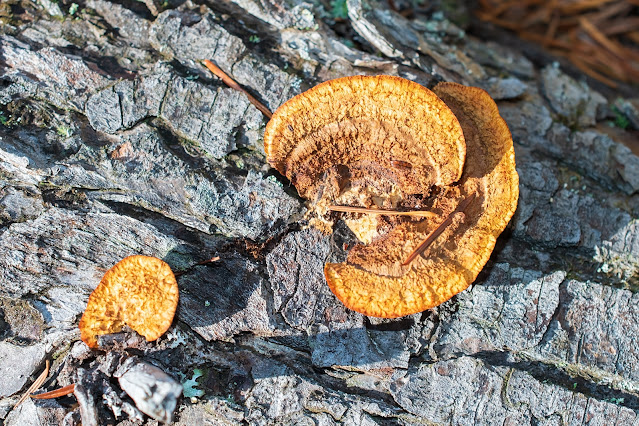Some mushrooms like soil, others look for wood. But not just any wood; it has to be the right kind, the right age, even the right location. But how do they find it, in a broken environment? For example, in a forest where there are scattered logs, some conifers, some deciduous, some green, some old and dry, some exposed, many hidden under a thick coating of moss. And the mushrooms which grow on these logs drop their spores vertically from gills or pores on the underside, sometimes barely millimetres away from the wood; how, then, do they manage to find a good home on the right sort of log many metres away?
 |
| Rusty gilled polypore,Gloeophyllum saepiarium, almost flat on the log. |
 |
| Rusty gills on the end of a log; here the spores have a better chance, it seems. |
 |
| Dyer's polypore, Phaeolus schweinitzii, on the ground under dead wood. |
The spores are formed in the gills or pores; when they are ready, they are expelled into the space between the gills and gravity pulls them down. And then?
Once the spore has fallen below the bottom edge of the mushroom cap, and is clear of the gills, it strikes air that is not still. Even on what looks like a windless day, there are always slight breezes. While a human may not feel them, they are usually strong enough to be felt by a spore that is only about a hundredth of a millimetre long. These micro-breezes may pick up the spore and carry it higher into the air and away from the parent mushroom. The spore may come to rest a metre or a kilometre or even further away from the mushroom. (AustralianFungi)
And this helps, too:
Here we show that evaporative cooling of the air surrounding the pileus (the cap) creates convective airflows capable of carrying spores at speeds of centimeters per second. Convective cells can transport spores from gaps that may be only 1 cm high and lift spores 10 cm or more into the air. This work reveals how mushrooms tolerate and even benefit from crowding and explains their high water needs. (PNAS)
Witches' butter forms its spores on the surface of the jelly. This allows the spores also to be carried by rain.
~~~~~~~~~~~~~~~
A algunos hongos les gusta vivir en el suelo; otros buscan sitios en madera. Pero no cualquier madera: son exigentes, y tiene que ser la madera de su tipo favorito, de la edad adecuada, y hasta en el ambiente preferido. Pero, ¿cómo la van a encontrar, en un sitio variable? Por ejemplo, en un bosque donde hay troncos caídos, algunos coníferos, otros de hoja caduca, algunos todavía verdes, otros bien secos, algunos expuestos al aire y al sol, otros bajo una gruesa cobija de musgos. Y los hongos que crecen en estos troncos dejan caer sus esporas desde laminillas o poros en la superficie inferior, donde a veces apenas milímetros les separa de la madera. ¿Cómo es, entonces, que logran instalarse en otro sitio en un tronco adecuado tal vez a muchos metros de distancia de su origen?
Fotos:
- Un políporo, Gloeophyllum saepiarium, creciendo casi pegado al tronco.
- Otros de la misma especie en el extremo del tronco; aquí parece que las esporas tienen mejor posibilidad de viajar.
- Un políporo, Phaeolus schweinitzii. Este está creciendo en el suelo debajo de madera muerta.
Las esporas se forman dentro de las laminillas o los poros; cuando están listos, se lanzan al espacio entre las laminillas y caen al aire libre. ¿Y entonces?
Una vez que la espora ha caído debajo del borde del sombrero y queda libre de las laminillas, se encuentra en aire inquieto. Aun en lo que parece un dia sin viento alguno, siempre hay una brisa ligera, que aunque no la puede sentir un humano, normalmente es suficientemente fuerte como para que la sienta una espora que mide apenas un centésimo de un milímetro. Estas mini-brisas pueden levantar la espora, llevarla para arriba y transportarla lejos del hongo original. La espora puede depositarse a un metro, un kilómetro, o aun más lejos del hongo. (AustralianFungi)
Y esto puede ser de ayuda también:
Aquí demonstramos que el enfriamiento por evaporación del aire que rodea el sombrero crea corrientes de aire por convección que son capaces de llevar las esporas a velocidades de varios centímetros por segundo. Zonas convectivas pueden transportar las esporas desde espacios que miden solamente 1 cm. verticalmente y levantarlas 10 cm. o más al aire. Este trabajo demuestra como es que los hongos toleran y hasta reciben beneficio por vivir apiñados; también explica su necesidad de una suficiencia de agua. (PNAS)
Foto:
4. Hongos con laminillas creciendo amontonados en un tronco.
5. La "mantequilla de brujas", Tremella mesenterica, forma sus esporas en la superficie de la masa gelatinosa. Esto permite que las esporas se dispersan con la lluvia. Estas estan creciendo en un tronco de arce. Vive únicamente en madera caducifolia.



No comments:
Post a Comment
I'm having to moderate all comments because Blogger seems to have a problem notifying me. Sorry about that. I will review them several times daily, though, until this issue is fixed.
Also, I have word verification on, because I found out that not only do I get spam without it, but it gets passed on to anyone commenting in that thread. Not cool!